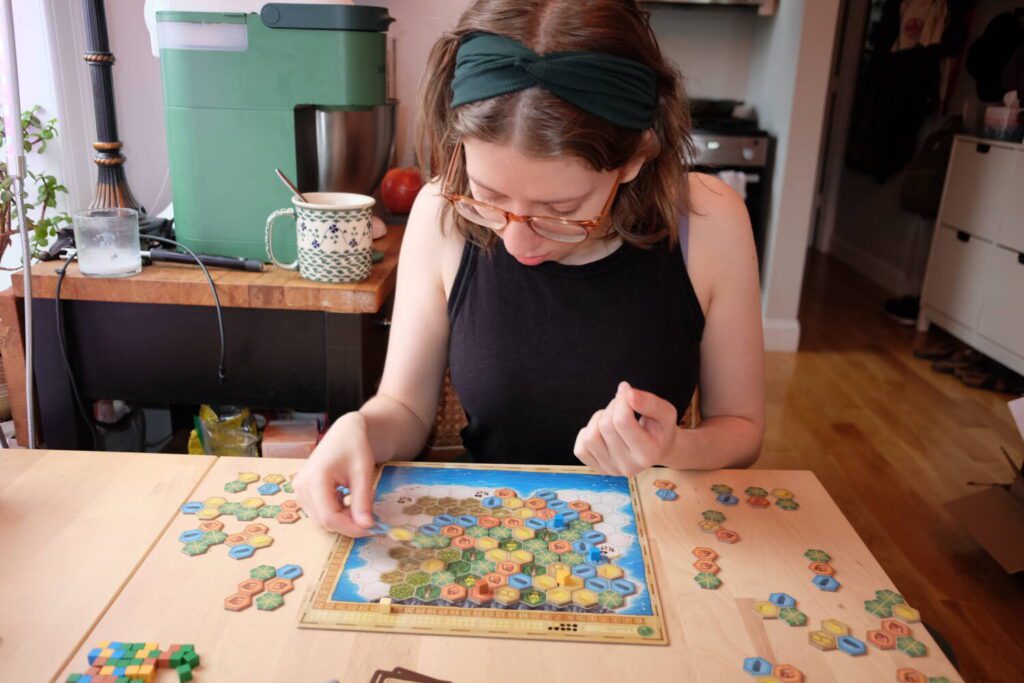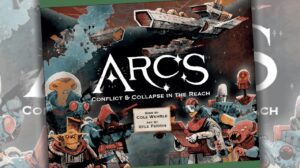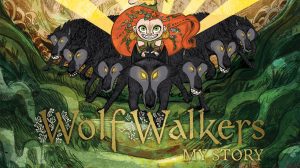Disclosure: Meeple Mountain received a free copy of this product in exchange for an honest, unbiased review. This review is not intended to be an endorsement.
My Island, Reiner Knizia’s follow-up to his 2020 legacy tile-layer My City, has some big shoes to fill. Not everyone at Meeple Mountain agrees, and while I do understand why David didn’t care for it, that three-star rating is a travesty. My City is a wonder. I have played the full legacy game twice, with two different sets of players, and it was an absolute joy both times.

Beachfront Property
My City and My Island share core mechanics. Each player has an identical set of unique tiles. In the case of My City, they were tetromino buildings. For My Island, the tiles are groups of two-to-four hexagons with different terrain types. A central deck of cards, each showing one tile, is shuffled, and each turn is a lightning quick pair of actions: someone reveals the top card, and everyone has to place their copy of that tile on their player board.
It’s hard to explain more than that, because both My City and My Island alter the rules as you play. What you’re trying to accomplish changes from chapter to chapter (8 in total) and even episode to episode (three per chapter). As with all tile-laying games, ultimately the goal is to cover as many spaces as possible, while forming groups and connecting locations, etc., etc., etc.
This review is a few months in the making, because I wanted to finish the campaign before writing it. I’m glad I waited. My Island is a fascinating experience, which I mean as both a good and a bad thing. If you loved My City, will you love My Island? Maybe. If you didn’t care for My City, will you still dislike My Island? Maybe. I’m afraid it’s time for some nuance.

New Aunts
It didn’t take long for me to start referring to My Island as the Master’s Degree to My City’s Bachelor’s. This is a different beast. While the initial chapter didn’t make much of an impression, with too little going on, that changed quickly. Once the scoring conditions of Chapter 2 were introduced, the game fleshed out. Decisions became more meaningful. They also became more demanding. Hexagonal tiles necessitate more thought than tetrominos. and the variety of simultaneous scoring conditions make the whole experience more of a brain-burner than the light, peppy original.
That’s not a point against My Island, but it does mean this game isn’t necessarily for the same people. You could crank out an entire chapter of My City, three games, in less than an hour, and immediately dive back in for more. With My Island, the same feat will take you closer to two hours, possibly over, and you’ll be exhausted enough at the end of those two hours that you’re ready to take a break.
There are more requirements here that bleed over from one Chapter to the next, or have negative consequences when left unaccomplished. That frustrated my group. “I would have made a point of doing that if I’d known.” I can understand that, though I generally assumed that I should get everything done as quickly as possible, so I wasn’t bothered. If you have players who are sensitive to learning the hard way, a theme that will come up again, you may want to steer clear.
Adding to the bulked up playtime: the hexagonal pieces are much harder to find than My City’s buildings. After flipping over a card, you usually spend a few seconds trying to find your exact piece, even once you’ve sorted them. This got better as the game went on, but it never went away, even after 23 games.
So then, the cautionary points are as follows: significant increase to playtime, an increase in post-game exhaustion, an uptick in unforeseen consequences, and a decrease in ease of play. None of those mean My Island is bad, but they do mean it’s for someone different.

Old Aunts
There is a lot more to decide here. If you’re inclined towards spatial puzzles, and open to your best laid plans being ruined by an inconvenient card flop, you’ll find much to love. The changes to the system crack it wide open. There’s more space for creativity in My Island than there was in its predecessor.
There are some wild and unexpected additions to the design, which push it into heavier, more interactive directions. Would you like to play My City and Through the Desert simultaneously? My Island has you covered. Some players were bothered by the multi-player solitaire of the original design, and My Island certainly remedies that. If your play group is particularly competitive, later chapters can get outright nasty. From Chapter 2 to Chapter 5, My Island was unanimously cooking.
There are growing pains once you hit Chapter 6, particularly if any members of your group are frustrated by misremembering a rule or two. The changes later in the game become hard to track, because they become so small. You remember that groups of eight are good, but you don’t remember why. You know you were trying to connect Locations A and B via roads, but maybe that’s not something you need to do anymore? And if I put a house by the temple, what happens, again? Oh, that doesn’t happen anymore?
If everyone in your group is okay with [redacted] around and finding out, you’ll be fine. I was made more sensitive to the changes because one member of my trio has a low tolerance for such things. Even speaking charitably, I think My Island scrapes against the limits of what people can reasonably alter from game to game, but scraping against isn’t the same as breaking.

All’s Well
You know what was incredible? The final game. We decided to do Chapters 7 and 8 in a single, Herculean push to finish. The rules for the final three episodes are nearly identical, which gave everyone a chance to settle in. By the third game in that set, we knew what we were doing. Every decision was tense. We sweated over each tile. Even with the outcome of the larger game assured—my lead was insurmountable—we were all so invested, attentive, and into it, that the game went out with an incredible bang.
My Island is for a narrower band of people than My City was, and there isn’t a full overlap between those bands. It may try your patience from time to time. It may be more than you want it to be. I wouldn’t fault you in either case. I went through ups and downs. I would play My City’s entire campaign again right now, but I don’t think I would play My Island again. I don’t think I would.
But I might.













You have no idea how much I am looking forward to this campaign!